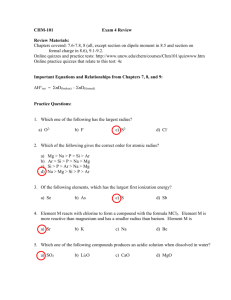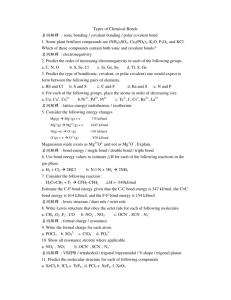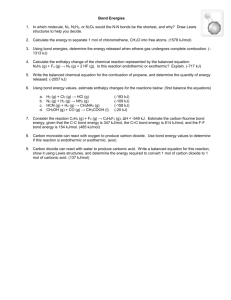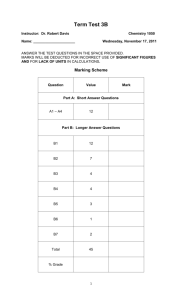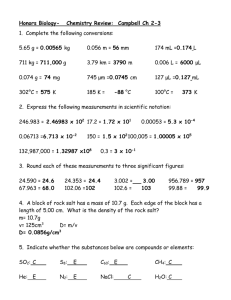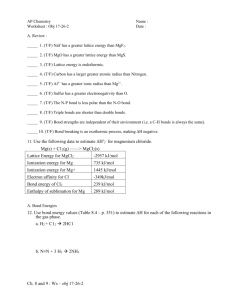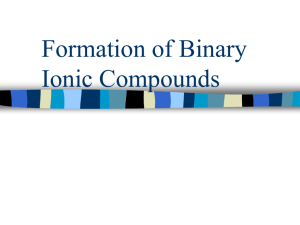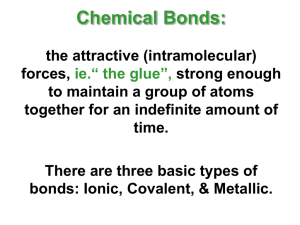Key
advertisement
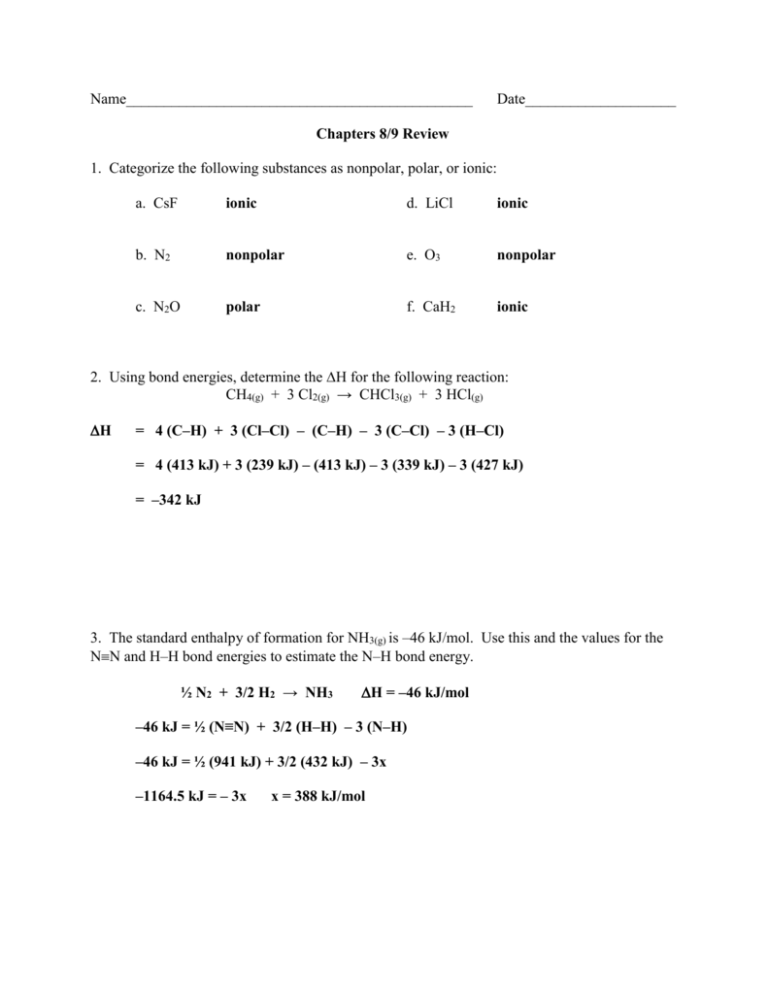
Name______________________________________________ Date____________________ Chapters 8/9 Review 1. Categorize the following substances as nonpolar, polar, or ionic: a. CsF ionic d. LiCl ionic b. N2 nonpolar e. O3 nonpolar c. N2O polar f. CaH2 ionic 2. Using bond energies, determine the for the following reaction: CH4(g) + 3 Cl2(g) → CHCl3(g) + 3 HCl(g) H = 4 (C–H) + 3 (Cl–Cl) – (C–H) – 3 (C–Cl) – 3 (H–Cl) = 4 (413 kJ) + 3 (239 kJ) – (413 kJ) – 3 (339 kJ) – 3 (427 kJ) = –342 kJ 3. The standard enthalpy of formation for NH3(g) is –46 kJ/mol. Use this and the values for the NN and H–H bond energies to estimate the N–H bond energy. ½ N2 + 3/2 H2 → NH3 H = –46 kJ/mol –46 kJ = ½ (N≡N) + 3/2 (H–H) – 3 (N–H) –46 kJ = ½ (941 kJ) + 3/2 (432 kJ) – 3x –1164.5 kJ = – 3x x = 388 kJ/mol 4. For the following molecules: a. ClO2– b. N3– a. draw a Lewis dot structure calculate formal charges give the shape and hybridization for the central atom show resonance structures where appropriate c. SOCl2 (S is central atom) d. SO3 e. CBrI3 f. KrF4O bent, sp3 O–Cl–O -1 +1 -1 b. c. [ N≡N–N ]– ↔ [ N=N=N ]– ↔ [ N–N≡N ]– 0 +1 -2 -1 +1 -1 O -1 O Cl–S–Cl ↔ 0 +1 0 d. O +1 ↔ ↔ O=S–O 0 +2 -1 -1 0 O -1 ↔ O–S=O -1 +2 0 I I –C– I tetrahedral, sp3, all formal charges = 0 Br f. O -1 0 F F 0 Kr 0 F +1 F 0 trigonal pyramidal, sp3 Cl–S–Cl 0 O -1 -1 +2 -1 e. -2 +1 0 all zero O 0 O–S–O Cl–S–Cl linear, sp square pyramidal, sp3d2 trigonal planar, sp2 5. Consider the hydrogen cyanide molecule, HCN. Draw the Lewis dot structure, then sketch the molecule showing the orbitalsLabel the type of bond or ) formed by each orbital overlap. H–C≡N: C H N 6. Organic compounds vary greatly in the way their C atoms bond to each other. In the following compounds, they form a single ring. Draw a Lewis structure for each: (a) C3H4; (b) C3H6; (c) C4H6; (d) C4H4. H (a) (b) C H C C H H H H C H H C C H H (c) H H H C C C C H H (d) H C C C C H H H H 7. Draw the molecular orbital energy level diagram for F2. Determine the bond order and predict whether the molecule is paramagnetic or diamagnetic. 2p* ↓↑ ___ 2p ___ ↓↑ ___ ↑ ↓↑ ___ ↓↑ ___ ↑ 2p 2p* ___ 2p 2p 2s* 2s ___ ↓↑ ↓↑ 2s ___ 2s bond order = (8 – 6) / 2 = 1 diamagnetic 8. Using the following information, draw the energy cycle for NaCl and determine its lattice energy. ionization energy of Na 496 kJ/mol bond energy of Cl2 244 kJ/mol electron affinity of Cl –349 kJ/mol ΔH of sublimation for Na 108 kJ/mol ΔHºf (NaCl) –411 kJ/mol lattice energy = 411 kJ + 108 kJ + 496 kJ + 122 kJ – 349 kJ = –788 kJ Na+(g) + Cl(g) Na+(g) –349 kJ 122 kJ + ½ Cl2(g) Na+(g) 496 kJ + Cl– (g) Na (g) + ½ Cl2(g) 108 kJ Na(s) + ½ Cl2(g) lattice E 411 kJ (changed sign) NaCl(s) This is absolutely NOT drawn to scale!

